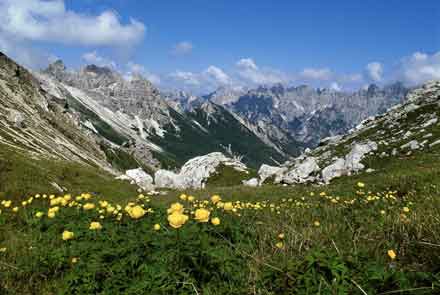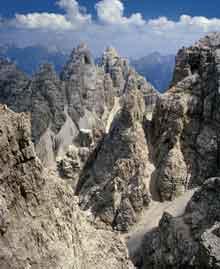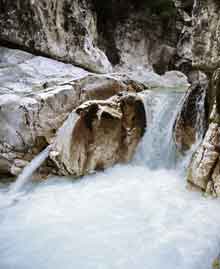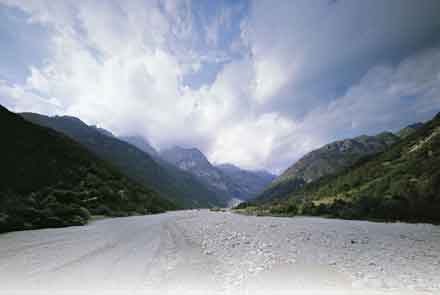| |
The natural Park of the Friuli Dolomites which covers an area
of 37,000 hectares incorporates one of the most beautiful areas of
the region. It includes the municipalities of Andreis, Cimolais, Claut,
Erto, Casso, Frisanco and Tramonti di Sopra which are part of the
province of Pordenone; and Forni di Sopra and Forni di Sotto which
are both in Udine.
The main area of the Park, which in the past was not easily accessible
due to its complex mountain network, has been preserved thanks to
limited intrusion by humans. Its habitat and its spectacular landscape
offer a high degree of wilderness, which makes this area a paradise
for excursions, trekking and mountain climbing.
Many itineraries have been carefully modified and provided with accommodation
facilities. They are spread over a territory of great geological interest,
probably the most complex territory of the Friuli-Venezia Giulia region.
Due to erosions caused by pollution, the rocks of the Dolomites have
been re-modelled into different, spectacular shapes whose range of
colours modifies according to the different light.
The “bell-tower” of Val Montanaia is the symbol of the Monfalconi
area, which is part of a typical dolomite landscape. It is an imposing
rocky tower which was climbed for the first time in 1902 by the two
Austrian alpinists, Saar and Glanvell.
An easy route made by the Alpine troops at the beginning of the 1900s,
leads you up to the Casera Casamento, where dinosaur footprints have
been recently discovered embedded in the rocks. This discovery is
of great interest. |
|
|
The
footprints belonged to a two-footed animal with three digits on
each foot, which probably lived in the Triassic era 215 million
years ago, when the area was covered by vast mud flats.
An easy panoramic route from Costa to Casso, also known as the ancient
“coal road” (Trui dal Sciarbon), leads you to the Zemola
Valley, which is important from natural, historical and ethnographical
viewpoints. Its pleasant landscape blends with the ancient and severe
architecture of Erto and Casso, unfortunately, the images evoked
by the tragic dam-burst and flooding of the Vajont valley inevitably
dims the charm of this place.
At the end of 1600, the road was used by women who carried heavy
panniers of coal on their shoulders. The coal was produced in the
coal mines (poiàt) and transported down to Longarone. From
there, it was loaded on to rafts which transited along the Piave
river to Venice. This exhausting activity took place until the fifties
but only in the last years was a cable car used to transport the
coal down to the Piave valley.
It is easy to see many wild animals along the route from the Settimana
to the Cimoliana valleys leading to the park or while stopping at
the many, recently refurbished refuges. The patient and careful
watcher is rewarded by the unforgettable sight of bucks, deer, chamois,
and, higher up, of rock goats and marmots which often peep out from
the vegetation and the rocks of their habitat. More easily discernible
is the silent but spectacular flora of the Park. Its important species
are surely one of the reasons why this territory has become a protected
area. The following endemic species such as the sandwort (Arenaria
huteri), the Daphne blagayana, a species of Thymelaeacea, the Froelich
gentian (Gentiana froelich), the Primula tyrolensis and the Primula
Wulfeniana are but some of the many valuable species of plants growing
in the area. We should not forget more common species such as the
splendid lady’s slipper (Cypripedium calceolus), a kind of
orchid which blossoms profusely at the beginning of summer.
Besides the flora and the fauna, the park also offers some fresh
springs which turn into streams and small torrents and break into
the silent woodland, remodelling its landscape and its rocks.
Some promotional projects for the Natural Park of the Friuli Dolomites
have been set up particularly in schools. Over the last years, many
students from all over the region and surrounding areas, have learned
more about this naturalistic area thanks to the guided tours which
take place throughout the year and are available to everyone. This
is an interesting way of learning how the environment mutates in
the different seasons. To help the visitor appreciate and enjoy
the nature reserve, six visitors’ centres have been set up
in the territory, some of which are open all year round, others
by appointment only and only during high season (summer time). They
all give additional information about the protected area.
The visitors’ centre at Cimolais is an important point of reference
for tourists who wish to have information about the many excursions
around the Park, which are ideal for those visitors venturing into
the Natural Park for the first time. In particular, there is an
educational tour which offers additional information about the fauna,
flora, rock formations and vegetation. A brief interlude to familiarize
the visitor with the surrounding, natural environment. The visitors’
centre at Erto is entirely dedicated to the floods which happened
after the Vajont dam burst in 1963. The area is divided into two
sections, one of which hosts an exhibition of old photographs which
take us back over the centuries, to discover the traditions and
habits of the Vajont inhabitants prior to the tragic event of 9
October 1963 and then to that fatal night, when a huge rockslide
from mount Toc fell into the artificial lake, causing the dam to
collapse and the death of 2,000 people. The other section gives
a detailed analysis of the whole event, starting from the hydroelectric
project of the Vajont right up to the court hearing following the
tragedy.
The story is narrated on descriptive panels; it is also possible
to consult technical charts and examine and compare the plastic
models of the area. The multimedia room offers a cd-rom which makes
it possible to have a more general view of the catastrophe through
the computerized reconstruction of the rockslide and original films
dating back to that period.
The area of Andreis hosts a bird-life sanctuary, which was set up
by an association for the care of wounded birds in cooperation with
the local vet association. The area consists of a research centre,
a study area, and a network of aviaries. The most interesting part
is surely the aviaries, which can be found to the north of Andreis.
They host different species of birds such as hawks, kestrels, buzzards,
tawny owls, sparrow hawks, one goshawk and one golden eagle. Some
of these birds have been so badly injured that will have to remain
in captivity; others are freed once they are fully recovered. During
convalescence, they are kept in special cages which are kitted out
with rehabilitation equipment. When these birds are set free, the
Park organises events, which are attended by adults and students,
with a view to making them more environmentally aware. In the upper
Tagliamento valley, the visitors’ centre at Forni di Sopra
hosts the exhibition “La vegetazione del Parco”. It is
about the vegetation of the area and is combined with excursions
tailor-made for children, such as the “children’s pathway”.
The visitors’ centre at Forni di Sotto has an exhibition on
the different species of woodland, which is named “Le tipologie
forestali del Parco”.
|
|
|



 

It also includes interesting itineraries concerning the archaeology
of the woodland, such as that of the “Teleferica della Val Poschiadea”
(Cable car of the Poschiadea Valley).
An additional visitors’ centre is to open soon at Frisanco and
it will host an exhibition about dairy farming. The idea of an educational
tour about the ancient dairy techniques was carried out after a former
local dairy was refurbished. The tour describes the activities in a
shepherd’s hut and the production of typical products.
The nearby “Forra del Cellina” Nature Reserve is adjacent
to the parkland which extends over the municipalities of Andreis, Barcis
and Montereale Valcellina. This Reserve includes the mountainous area
between Barcis and Montereale which has been eroded into a gorge by
the Cellina torrent. It carries the sediment into the Pordenone area
where it is deposited, forming wide river beds.
This narrow gorge is similar to a canyon and is characterized by fluvial
erosions which over the centuries, have created appealing rock sculptures
such as the “marmitte dei giganti”.
A winding road crosses the left side of the gorge for about ten kilometres
up to the green lake of Barcis. Today, this attractive trail is not
open, but it is due to be refurbished thanks to European Community funding.
The tormented aspect of this valley led the most prominent poet of the
Cellina valley, Giuseppe Malattia della Vallata (1875-1948), to believe
that Dante may have found inspiration for spirals of his Inferno right
here.
|
|